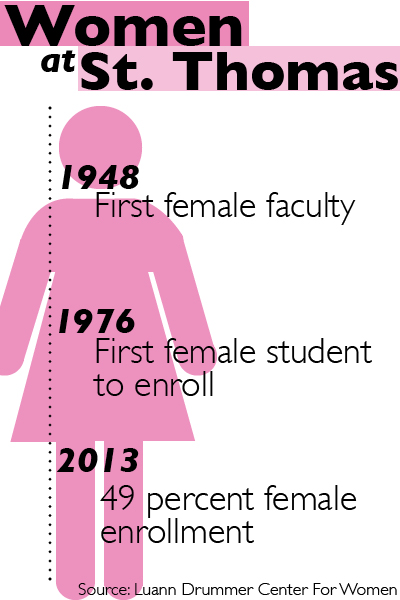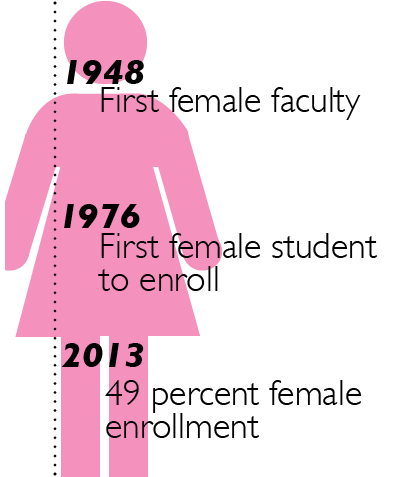
President-elect Julie Sullivan is the first female chosen to be lead the university, but her path to the position has been paved by women throughout St. Thomas’ history.
In the fall of 1977, 211 female students became the first of their gender to enroll at the formerly all-male university. This fall, 2,947 women enrolled according to the Office of Institutional Effectiveness Census.
Susan Alexander, executive adviser to the president, said since she first arrived as a faculty member in 1981, St. Thomas has grown into a welcoming place for women.
“I think (the St. Thomas population) has tilted more toward women in the past few years, but going from zero women in 1976, we went to a very attractive place for women,” Alexander said. “Not the first year, but we built and built and built.”
Athletics
Athletic Director Steve Fritz said many women’s sports were added in 1977, including basketball, swimming, softball and volleyball. Fritz said the college added soccer later.
“One of the things we wanted right from the beginning was that we did not want them to feel that they were women attending a male school,” Fritz said. “We wanted the feel that they were true partners in this whole thing.”
St. Thomas is now home to 10 varsity women’s sports teams. Fritz said women’s sports teams showed early success 35 years ago and have grown from there.
“The quality and reputation and everything else that was involved with the women’s program grew so quickly that it got pretty ingrained here pretty quick,” Fritz said.
Student leadership
St. Thomas athletics were not the only thing that changed during the 1977-1978 school year. Undergraduate Student Government, then called the All College Council, began accepting women into the group that year.
Director of Alumni and Constituent Relations Rachel Wobschall was a member of the first class of women at St. Thomas, and she was the first and only woman on All College Council her freshman year.
“One of the things that the president would say at that time was always, ‘well you guys, and Rachel,’ because I was the only woman, so I was very aware of that status,” Wobschall said.
Wobschall was in ACC for four years at St. Thomas, and she became the ACC’s first woman president her senior year in 1980.
Wobschall not only made strides in the ACC, but she was also the first woman to receive the Tommie Award in 1981. Seven women have received the award since Wobschall.
Wobschall still considers the award a huge accomplishment.
“I knew some of the previous Tommie Award winners … and I knew that those were individuals who were very highly respected, so it was a big honor,” Wobschall said.
Presence on campus
The undergraduate student population has slightly more males than females (51 percent male to 49 percent female), the Office of Institutional Effectiveness Census reported the percentage of female students has been rising for the last five years.
Alexander said becoming a co-ed institution was important in making St. Thomas a stronger school.
“It is hard for single-gender institutions to thrive, particularly male single-gender,” Alexander said. “The president at that time, Monsignor Terrence Murphy, said that’s what we have to do in order survive and thrive. But even just to survive.”
Freshman Erin Jensen said having females with different viewpoints benefits St. Thomas.
“Incorporating the feminine aspect through classes… it brings different viewpoints,” Jensen said. “It gives a wider range of opinions and thoughts because men and women can think differently.”
Administrative positions
Alexander said a noticeable transformation in her time at St. Thomas has been that there are more females in administrative positions at St. Thomas.
Although several prominent members of the St. Thomas administration are female, Alexander said many people were still critical of the lack of diversity in St. Thomas’ positions of power until Feb. 14’s presidential announcement.
“People still thought that even though our chief academic officer is a woman, vice president of student affairs (is a woman) … that people would still have said that we don’t have a diverse upper administration,” Alexander said. “I think that changed (when Sullivan was hired).”
Junior Courtney Falk said while she doesn’t think having a female president will change campus. She said Sullivan’s leadership will be a step in the right direction.
“I definitely think it is empowering for females,” Falk said.
Alexander said having women in positions of authority is good for female students at St. Thomas.
“I think it gives women a role model,” Alexander said. “It still matters if you see someone who looks like you, who is like you, doing a job.”
Freshman Joe Bush said having a strong female faculty presence on campus would benefit female students.
“Now that there are women students, they can probably relate a little bit better to the teachers sometimes,” Bush said. “It’s not as much male dominance being felt.”
Alexander said she is pleased with the progress and support St. Thomas women have given each other.
“We’ve had very talented women in administration here, and the success of these women has been good for us and for our women students and faculty and staff,” Alexander said. “But I also think that we have been people that men at the institution can turn to, that they’ve felt comfortable with us at the institution.”
Gabrielle Martinson can be reached at mart5649@stthomas.edu.



